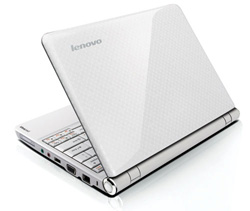Lenovo IdeaPad S12 pushes netbooks in new directions; Intel, Microsoft push back

The battle over the role of netbooks appears to be escalating. Computer makers, aided by Nvidia, are broadening the features and performance of netbooks--adding larger displays and more-capable graphics. The latest example is Lenovo, which just announced a 12-inch netbook--the first from a major computer maker with Nvidia's Ion platform. Meanwhile, Microsoft and Intel seem to be doing their best to keep netbooks in their place.

The GeForce 9400M is obviously a significant upgrade over Intel's GMA950 integrated graphics--in its release Nvidia claims it will offer 10X better performance. Both Nvidia and Lenovo state that the IdeaPad S12 will be able to handle the Aero interface in Vista and Windows 7, HD video including 1080p and Blu-ray, and some 3D games. There's no doubt that laptops equipped with the GeForce 9400M can handle those sorts of tasks, but since I've never seen tests with an Atom N270 and 1GB of memory, we'll have to wait and see what this combination really delivers. Having tested many netbooks with the Atom N270 and 945GSE, I can say that current models struggle even with 720p video playback, so enhanced video playback on 1366x768 displays--either at 10- or 12-inches--should be a desirable feature.
The other question mark with Nvidia's Ion is battery life. Lenovo states that the IdeaPad S12 will have a running time of up to six hours with a six-cell battery, which sounds better than I expected. But again, we'll have to wait and see.
The IdeaPad S12 won't be available until June, so the company hasn't announced specific configurations. Lenovo said it will start at $449, and will have 1GB of memory, up to a 160GB hard drive and an ExpressCard slot for a 3G data card. The IdeaPad S10 also has an ExpressCard slot, but an upcoming model, the IdeaPad S10-2, will instead have an optional internal 3G radio. This 10.1-inch model will eventually have the higher-resolution (1366x768) display as well, though the first ones available later this month will max out at 1024x600.
Ion has reportedly been the source of much friction between Intel and Nvidia. At a tech conference last week, Nvidia CEO Jen-Hsun Huang complained that Intel was selling Atom a la carte for $45, but offering OEMs both the processor and chipset for only $25, presumably to discourage its customers from using Ion--a charge that Intel denies. Around the same time, Intel revealed plans for an updated netbook and nettop platform, known as Pine Trail, with both better processor and graphics performance. Rather than using a separate chipset with graphics, the new platform includes a processor (Pineview) with an integrated GPU and memory controller. In addition, Broadcom is reportedly working with Intel on an optional chip for Pine Trail that will offload 720p and 1080p playback.
Conspiracy theorists view all of this as a plot to kill Ion: If you want Atom, you'll have to buy Intel's graphics as well, even if you plan to use someone else's chipset. But Intel is planning to do the same thing with its mainstream desktop and notebook platforms at 32nm, so there are both technology and business reasons behind this product roadmap. In addition, Intel will soon offer an alternative for 12-inch laptops: a line of CULV (Consumer Ultra Low-Voltage) chips. Laptops based on these should offer better performance than netbooks, but cost significantly less than premium ultraportables--well under $1,000. I expect to see several of these CULV notebooks at Computex in Taiwan next week. (AMD already has a similar product, the Athlon Neo, which is used in HP's Pavilion dv2z.)
What seems certain is that both Intel and Microsoft prefer to draw a clearer line between notebook and netbook based in part on screen size. Microsoft already has a set of maximum specs for netbooks--including a display that is 12.1 inches or smaller--in order to qualify for a version of Windows XP that sells for as little as $15. ZDNet's Mary Jo Foley thinks Microsoft is preparing a similar set of maximum specs for Windows 7 netbooks, which could cut the screen size to 10.1 inches or smaller, in order to get the low-cost license. As widely reported, Windows 7 Starter Edition will also support only three concurrent applications. Strictly speaking, computer makers can put any version of Windows 7 that they'd like on a netbook, but from a practical standpoint, to remain competitive on price, they will have to meet Microsoft's requirements.